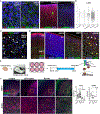LIF signaling regulates outer radial glial to interneuron fate during human cortical development
- PMID: 37673072
- PMCID: PMC10591955
- DOI: 10.1016/j.stem.2023.08.009
LIF signaling regulates outer radial glial to interneuron fate during human cortical development
Abstract
Radial glial (RG) development is essential for cerebral cortex growth and organization. In humans, the outer radial glia (oRG) subtype is expanded and gives rise to diverse neurons and glia. However, the mechanisms regulating oRG differentiation are unclear. oRG cells express leukemia-inhibitory factor (LIF) receptors during neurogenesis, and consistent with a role in stem cell self-renewal, LIF perturbation impacts oRG proliferation in cortical tissue and organoids. Surprisingly, LIF treatment also increases the production of inhibitory interneurons (INs) in cortical cultures. Comparative transcriptomic analysis identifies that the enhanced IN population resembles INs produced in the caudal ganglionic eminence. To evaluate whether INs could arise from oRGs, we isolated primary oRG cells and cultured them with LIF. We observed the production of INs from oRG cells and an increase in IN abundance following LIF treatment. Our observations suggest that LIF signaling regulates the capacity of oRG cells to generate INs.
Keywords: cerebral cortex; human development; inhibitory interneurons; mechanisms of differentiation; neural progenitors; neurodevelopment; organoid models; pluripotent stem cells; radial glia; signaling mechanisms.
Copyright © 2023 The Authors. Published by Elsevier Inc. All rights reserved.
Conflict of interest statement
Declaration of interests A.R.K. is a co-founder, consultant, and member of the Board of Neurona Therapeutics.
Figures




References
Publication types
MeSH terms
Grants and funding
LinkOut - more resources
Full Text Sources
Molecular Biology Databases

